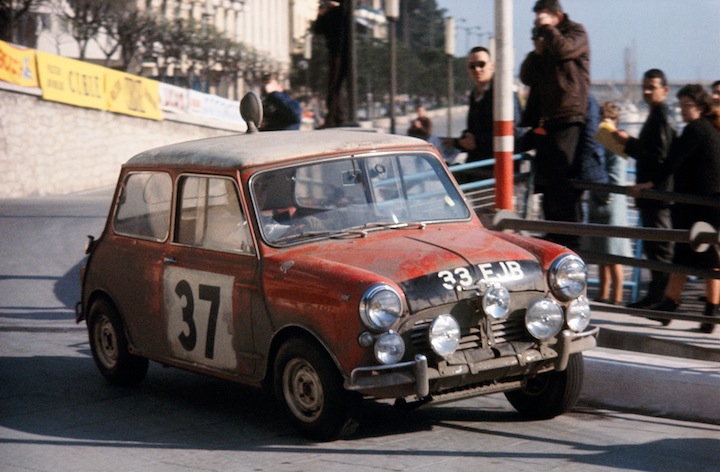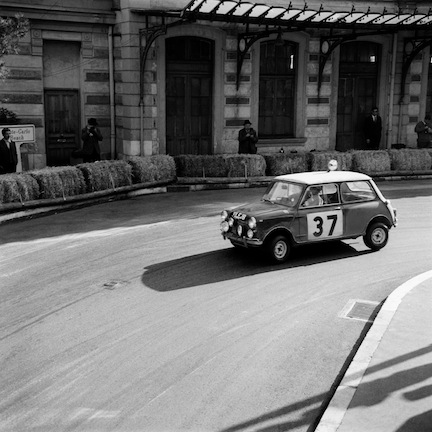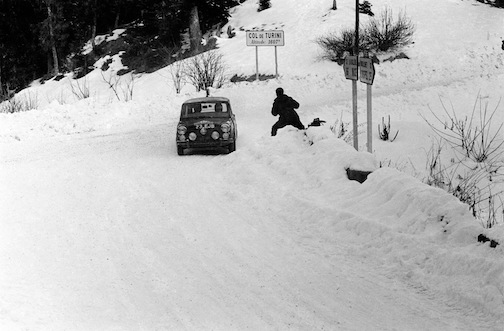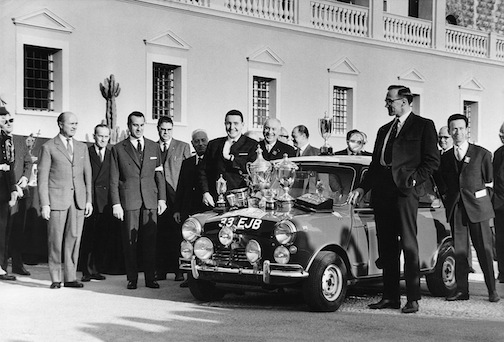50 years ago the classic Mini won the Monte Carlo Rally for first time

(January 24, 2014) Small car, huge win: it is now 50 years since one of the most spectacular victories in the history of international motor sport. On Jan. 21, 1964, the Mini Cooper S won the Monte Carlo Rally for the first time. It was the pairing of Northern Ireland’s Patrick (“Paddy”) Hopkirk and his co-driver Henry Liddon that pulled off the big surprise, resisting the supposed superiority of significantly more powerful rivals in their small British car.
Its faultless run over country roads and mountain passes, ice and snow, tight corners and steep gradients laid the foundations for the underdog-turned-giant-slayer to cement itself in both the hearts of the public and the annals of motor sport legend.
Indeed, the classic Mini’s dominance of the Monte Carlo Rally continued over the years that followed, Hopkirk’s Finnish team-mates Timo Mäkinen and Rauno Aaltonen adding two further overall victories — in 1965 and 1967 — to the British manufacturer’s collection.
 Now 80 years old, Paddy Hopkirk’s eyes still light up when he recalls the driving qualities of his winning car: “Although the Mini was only a little family saloon, technically it had a lot of advantages.
Now 80 years old, Paddy Hopkirk’s eyes still light up when he recalls the driving qualities of his winning car: “Although the Mini was only a little family saloon, technically it had a lot of advantages.
Paddy Hopkirk relives his thrilling race in a Mini 50 years ago.
Its front-wheel drive and front-mounted transverse engine were a great advantage, and the fact the car was smaller and the roads were ploughed, they were quite narrow, so I suppose that was an advantage. We were very lucky – the car was right, everything happened at the right time and came together at the right moment.”
It was the legendary “Night of the Long Knives,” the penultimate stage of the Monte, which put the Mini Cooper S with car number 37 and the now famous license plate 33 EJB on course for victory that winter of 1964.
Hopkirk crossed the finish line just 17 seconds off the pace set by his chief adversary Bo Ljungfeldt in the far more powerful V8-powered Ford Falcon. The handicap formula at the time — designed to even out the weight and power differences between the various cars — meant the classic Mini actually led the way in the overall standings. And Hopkirk defended his advantage in the sprint through the streets of Monte Carlo that rounded off the rally.
 At the winner’s ceremony he shared the cheers of the crowed with his team-mates. Timo Mäkinen’s fourth-place finish and Rauno Aaltonen’s seventh overall set the seal on the success of the Mini Cooper S and ushered in the era of the “Three Musketeers” in the Monte Carlo Rally.
At the winner’s ceremony he shared the cheers of the crowed with his team-mates. Timo Mäkinen’s fourth-place finish and Rauno Aaltonen’s seventh overall set the seal on the success of the Mini Cooper S and ushered in the era of the “Three Musketeers” in the Monte Carlo Rally.
The classic Mini’s victory was celebrated with particular excitement in its native Britain. Hopkirk received a congratulatory telegram from the British government and the Beatles were also among those leading the applause. “I got a telegram from the Beatles,” remembers Hopkirk. “That was followed by a photograph of the four of them autographed to me saying: ‘You’re one of us now, Paddy.’ And it’s very nice to have that nowadays.”
The triumph of the classic Mini in the Monte was lauded as a sensation by motor sport fans around the world. But this wasn’t a success that came entirely out of the blue: the small car developed by Alec Issigonis, then Deputy Technical Director at the British Motor Corporation, possessed an inherent sporting talent from birth.
The first person to spot this potential was John Cooper. The sports car designer was the driving force behind construction of a more powerful version of the car. The Mini produced only 34 hp at launch, but its front-wheel drive, low weight, wide track and comparatively long wheelbase made it an extremely agile four-seater and paved the way for its forays onto race circuits and rally courses.
As early as 1960, big-name racing drivers like Graham Hill, Jack Brabham and Jim Clark were spotted testing the cornering flair of the John Cooper-tuned small car on the Silverstone Formula One track. However, the classic Mini was most at home in rally racing.
 Patt Moss, sister of grand prix driver Stirling Moss, piloted it to wins in the Tulip Rally and Baden-Baden Rally in 1962. And by the following year, the diminutive British car was ready to burst into the public consciousness at the Monte Carlo Rally. Preceding years had been a tough learning experience for the works team, but now they would make people sit up and take notice. Rauno Aaltonen and Paddy Hopkirk drove the 55 hp Mini Cooper to a 1-2 finish in their class, which was good enough for third and sixth places overall.
Patt Moss, sister of grand prix driver Stirling Moss, piloted it to wins in the Tulip Rally and Baden-Baden Rally in 1962. And by the following year, the diminutive British car was ready to burst into the public consciousness at the Monte Carlo Rally. Preceding years had been a tough learning experience for the works team, but now they would make people sit up and take notice. Rauno Aaltonen and Paddy Hopkirk drove the 55 hp Mini Cooper to a 1-2 finish in their class, which was good enough for third and sixth places overall.
It was clear that the classic Mini was better equipped than any other car to pull off the classic David vs Goliath act. John Cooper had long suspected that the car had what it took. Back in 1959 he instructed Roy Salvadori to drive a prototype to the Italian Grand Prix in Monza. The journey itself turned into a race between Salvadori and fellow racing driver Reg Parnell at the wheel of an Aston Martin DB4. The result confirmed what Cooper had foreseen in his mind’s eye: the Cooper-prepared classic Mini arrived around an hour earlier than the much more powerful Aston.
Identifiable from a distance with their tartan red bodywork and white roofs, the six small racers dispatched by the BMC works team for the Monte Carlo Rally in 1964 were — at least on paper — fighting against the tide once more. The Mini Cooper S lined up at the start for the first time.
 Its new four-cylinder engine now had an increased 1071cc capacity and output had also been boosted to around 90 horsepower. This was a lot more than in previous years but still modest in the face of competition from the likes of the Mercedes-Benz 300 SE and Ford Falcon, whose six-cylinder and V8 units had three or four times more power at their disposal.
Its new four-cylinder engine now had an increased 1071cc capacity and output had also been boosted to around 90 horsepower. This was a lot more than in previous years but still modest in the face of competition from the likes of the Mercedes-Benz 300 SE and Ford Falcon, whose six-cylinder and V8 units had three or four times more power at their disposal.
The 33rd edition of the Monte Carlo Rally began — as was traditional at the time — with a nod to the origins of the event, the cars starting from nine European cities before converging on the French city of Reims. The Hopkirk/Liddon partnership got their journey with the Mini Cooper S under way in Minsk, while for Rauno Aaltonen and Tony Ambrose the Monte adventure started in Oslo, and Timo Mäkinen and Patrick Vanson set off from Paris.
The classic Mini successfully negotiated all these journeys and all six works cars were able to take their place in the 277-strong field in Reims. The first stage of the rally to Saint-Claude brought together the two cars which were to define the 1964 Monte from start to finish.
Bo Ljungfeldt roared to the top of the time sheets in his Ford Falcon, but Paddy Hopkirk remained hot on his heels in his Mini Cooper S.
The next leg of the rally was made up largely of mile-long flat-out sections, but Hopkirk refused to let his big-engined rivals build up a decisive advantage. The “Night of the Long Knives” would become the day of reckoning; this was the classic Mini’s chance to demonstrate its talents to the full. “It was quite snowy that year, so we had done a lot of practicing and preparing,” explains Hopkirk. “The Mini was particularly good downhill, and all the tests were up and downhill, so what we lost going up, I think we made up for going downhill.”
Irresistible handling, correct tire choice, Hopkirk’s gifts at the wheel and the snow — which slowed the bigger cars down — all came together and ensured that Hopkirk was able to take over the lead on the 1,607-meter (5,270 ft) Col de Turini. However, it remained a tight contest all the way to the finish, with Bo Ljungfeldt, as expected, again posting the fastest time on the final stage through Monte Carlo. However, Hopkirk was also squeezing everything from his Mini Cooper S once again and hung onto his advantage to wrap up the win.
“It’s not like rallying today when you know where you are. I had to do the final circuit, then the journalists told me I had won and I couldn’t believe it. It surprised the world and us, so it was very nice,” recalls Hopkirk.
